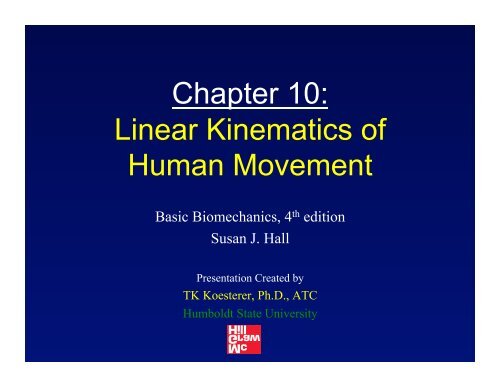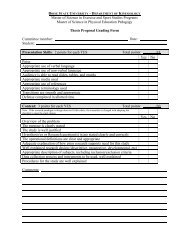Chapter 10: Linear Kinematics of Human Movement
Chapter 10: Linear Kinematics of Human Movement
Chapter 10: Linear Kinematics of Human Movement
Create successful ePaper yourself
Turn your PDF publications into a flip-book with our unique Google optimized e-Paper software.
Objectives• Discuss the interrelationship among kinematicvariables• Correctly associate linear kinematic quantities withtheir units <strong>of</strong> measure• Identify & describe effects <strong>of</strong> factors governingprojectile trajectory• Explain why the horizontal and vertical components<strong>of</strong> projectile motion are analyzed separately• Distinguish between average & instantaneousquantities & identify circumstance which each is aquantity <strong>of</strong> interest
<strong>Linear</strong> Kinematic Quantities• <strong>Kinematics</strong>: describes appearance <strong>of</strong> motion• Kinetics: study <strong>of</strong> forces associated with motion• <strong>Linear</strong> kinematics: involves the study <strong>of</strong> theshape, form, pattern and sequencing <strong>of</strong> linearmovement through time• Qualitative: major joint actions & sequencing• Quantitative: Range <strong>of</strong> motion, forces, distanceetc.
Distance & Displacement• Measured in units <strong>of</strong> length– Metric: meter, kilometer, centimeter, etc.– English: inch, foot, yard & mile• Distance:– Scalar quantity• <strong>Linear</strong> displacement:– Vector quantity: length & direction(compass directions, left, right, up, & down,or positive & negative
Speed & VelocitySpeed = length (or distance)change in timeVelocity (v) = change in position = Δ positionchange in timeΔ timev = displacement = dchange in timeΔ t
Speed & VelocityVelocity = position 2 - position 1time 2 - time 1• Velocity is a vector quantity– direction and magnitude <strong>of</strong> motion• Laws <strong>of</strong> vector algebra
<strong>10</strong>-2
AccelerationAcceleration (a) = change in velocity =change in timeΔvΔta = v 2 - v 1ΔtWhen acceleration is zero, velocity is constant
Positive/Negative Acceleration
Average & InstantaneousQuantitiesInstantaneous :• Instantaneous valuesAverage:• Average velocity = final displacementtotal time
Velocity Curve for Sprinting
Velocity Curves for Two Sprinters
<strong>Kinematics</strong> <strong>of</strong> Projectile MotionBodies projected into the air are projectilesHorizontal & Vertical Components• Vertical is influenced by gravity• No force (neglecting air resistance) affectsthe horizontal• Horizontal relates to distance• Vertical relates to maximum height achieved
<strong>Kinematics</strong> <strong>of</strong> Projectile MotionInfluence <strong>of</strong> Gravity• Major influence <strong>of</strong> vertical component• Not the horizontal componentForce <strong>of</strong> Gravity:– Constant, unchanging– Negative acceleration (-9.81 m/s 2 )Apex:– The highest point in the trajectory
<strong>10</strong>-6
<strong>Kinematics</strong> <strong>of</strong> Projectile MotionInfluence <strong>of</strong> Air Resistance• In a vacuum, horizontal speed <strong>of</strong> a projectileremain constant• Air resistance affects the horizontal speed <strong>of</strong>a projectile• This chapter, velocity will be regarded asconstant
Factors InfluencingProjectile TrajectoryTrajectory:• Angle <strong>of</strong> projection• Projection speed• Relative height <strong>of</strong> projection
<strong>10</strong>-9
Factors InfluencingProjectile TrajectoryAngle <strong>of</strong> Projection• General shapes– Perfectly vertical– Parabolic– Perfectly horizontal• Implications in sports• Air resistance may cause irregularities
<strong>10</strong>-<strong>10</strong>
Factors InfluencingProjectile TrajectoryProjection speed:• Range:Relative Projection Height:
<strong>10</strong>-14
Optimum Projection Conditions• Maximize the speed <strong>of</strong> projection• Maximize release height• Optimum angle <strong>of</strong> projection– Release height = 0, then angle = 45 0– ↑ Release height, then ↓ angle– ↓ Release height, then ↑ angle
Range at Various Angles
Analyzing Projectile MotionInitial velocity:• Horizontal component is constant– Horizontal acceleration = 0• Vertical component is constantly changing– Vertical acceleration = -9.81 m/s 2
<strong>10</strong>-17
Equations <strong>of</strong>Constant AccelerationGalileo’s Laws <strong>of</strong> constant accelerationv 2 = v 1 + atD = v 1 t + ½at 2V 2 2 = v 2 1 + 2 add = displacement; v = velocity;a = acceleration; t = timeSubscript 1 & 2 represent first or initial andsecond or final point in time
Equations <strong>of</strong>Constant AccelerationHorizontal component : a = 0v 2 = v 1D = v 1 tV 2 2 = v2 1
Equations <strong>of</strong>Constant AccelerationVertical component: a = -9.81 m/s 2v 2 = atD = ½ at 2V 2 2 = 2adVertical component at apex: v = 00 = v 2 1 + 2ad0 = v 1 + at
Goals for Projectiles• Maximize range (shot put, long jump)• Maximize total distance (golf)• Optimize range and flight time (punt)• Maximize height (vertical jump)• Optimize height and range (high jump)• Minimize flight time (baseball throw)• Accuracy (basketball shot)
Goals for Projectiles• Maximize range (shot put, long jump)– Shot put optimum angle is approximately42°– Long jump theoretical optimum isapproximately 43°; however, due to humanlimits, the actual angle for elite jumpers isapproximately 20° - 22°
Goals for Projectiles• Maximize total distance (golf)– Because the total distance (flight plus roll)is most important, trajectory angles arelower than 45°– Distance is controlled by the pitch <strong>of</strong> theclub• Driver ~ <strong>10</strong>°
Goals for Projectiles• Optimize range and flight time (punt)– Maximum range occurs with 45° trajectory– Higher trajectory increases hang time withminimal sacrifice in distance– Lower trajectory usually results in longerpunt returns• Less time for kicking team to getdownfield to cover the punt returner
Goals for Projectiles• Maximize height (vertical jump)– Maximize height <strong>of</strong> COM at take<strong>of</strong>f– Maximize vertical velocity by exertingmaximum vertical force against ground.
Goals for Projectiles• Optimize height and range (high jump)– Basic goal is to clear maximum height– Horizontal velocity is necessary to carryjumper over bar into pit– Typical take<strong>of</strong>f velocity for elite highjumpers is approximately 45°
Goals for Projectiles• Minimize flight time (baseball throw)– Baseball players use low trajectories (closeto horizontal)– Outfielders <strong>of</strong>ten throw the ball on onebounce with minimal loss <strong>of</strong> velocity
Goals for Projectiles• Accuracy (basketball shot)
Projecting for Accuracy
Minimum Speed Trajectory
Angle <strong>of</strong> Entry
Margin for Error
Free Throw Optimum Angle
Summary• <strong>Linear</strong> kinematics is the study <strong>of</strong> the form orsequencing <strong>of</strong> linear motion with respect totime.• <strong>Linear</strong> kinematic quantities include the scalarquantities <strong>of</strong> distance and speed, and thevector quantities <strong>of</strong> displacement, velocity,and acceleration.• Vector quantities or scalar equivalent may beeither an instantaneous or an averagequantity
Summary• A projectile is a body in free fall that is affectedonly by gravity and air resistance.• Projectile motion is analyzed in terms <strong>of</strong> itshorizontal and vertical components.– Vertical is affected by gravity• Factors that determine the height & distance <strong>of</strong> aprojectile are: projection angle, projection speed,and relative projection height• The equation for constant acceleration can beused to quantitatively analyze projectile motion.
The End












